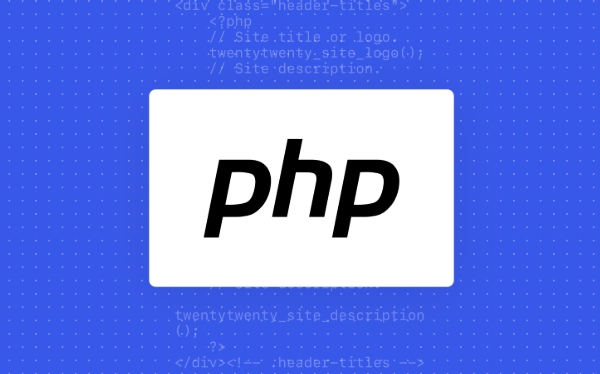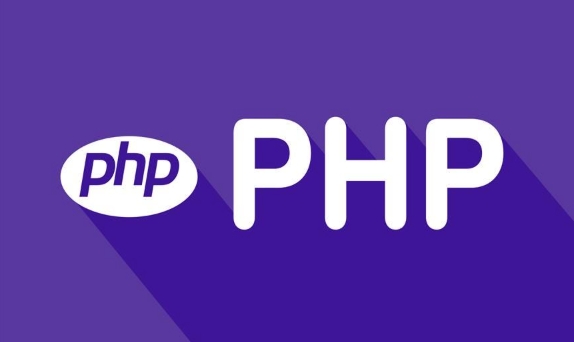It is not difficult to learn PHP from scratch. The key is to clarify the direction and follow the steps. First of all, it is necessary to clarify that PHP is mainly used for dynamic web development, which is especially suitable for interaction with databases, such as implementing user registration, login and other functions. The first step is to build an environment. It is recommended to use XAMPP or phpStudy to quickly run PHP files, and to improve efficiency with editors such as VS Code. When learning grammar, you should focus on mastering the basic structure, including conditional judgment, loops, function definitions and array operations, and you don’t have to memorize everything by rote. Finally, you need to practice through small projects, such as leaving a message book or logging into the system, contact form submission, database connection, and data addition, deletion, modification and inspection, and gradually improve your practical capabilities.

Learning PHP from scratch is not that difficult. The key is to clarify the direction and not get into the details of the grammar from the beginning. The following stages are the most important things for novices to pay attention to.

Let’s figure it out first: What is PHP used for?
Many people just started learning programming, and they heard that PHP is about to learn quickly, but they don’t know what it does. Simply put, PHP is mainly used for dynamic web development , especially dealing with databases, such as user registration, login, and message. PHP is very good at it.
Many of the blog systems you see now (such as WordPress) are written in PHP. So if your goal is to build a website backend, or want to understand how the website changes from a static page to "interactive", PHP is a good introductory language.

Step 1: Set up the environment, don't get stuck here
It is most likely for novices to get stuck in the "How to run PHP". In fact, there are many tools that can help you quickly start writing code, and you don’t need to mess around with the server at the beginning.
It is recommended that you do this:

- Install an integrated environment, such as XAMPP or phpStudy (the Chinese interface is more friendly)
- Put the written
.phpfile into the http://htdocshttp://localhost/你的文件名.php - Use a simple editor, such as VS Code, install a PHP plugin, and write code more conveniently
Don't worry about server configuration, write some code first and then run.
Learning grammar, the focus is on "using it" rather than "remembering it all"
PHP syntax is actually quite simple, such as outputting a sentence:
echo "Hello World";
There is a $ in front of the variable, and the array is used with array() or [] . These basic syntaxes can be started soon. But the mistakes that novices are prone to make are:
- Don't pay attention to the end of the semicolon
- The scope of variables is unclear
- Not proficient in array operation
It is recommended that you first master these basic structures:
- Conditional judgment (if/else)
- Loop (for / while / foreach)
- Function definition and call
- Array operations (add, delete, modify and check)
If you encounter a function you don’t understand, go to the official PHP document to check it directly, and don’t memorize it by rote.
Do a small project and don't just read the tutorial
Just reading tutorials without writing code means not learning. You can try making a simple message book or user login to the system, so you will get in touch with:
- Form Submission (GET/POST)
- Database connection (MySQL is recommended)
- Data addition, deletion, modification and query (CRUD)
For example, with the login function, you will learn how to use $_POST to receive data, and how to query the database to determine whether the username and password are correct.
Don’t pursue “perfect code” from the beginning, and let’s talk about the function first.
Basically that's it. PHP is quick to get started, but to really use it well, you still need to practice more, check more documents, and read more codes written by others. Gradually you will find that programming is actually a process of solving problems, and PHP is just a tool.
The above is the detailed content of PHP for Beginners. For more information, please follow other related articles on the PHP Chinese website!

Hot AI Tools

Undress AI Tool
Undress images for free

Undresser.AI Undress
AI-powered app for creating realistic nude photos

AI Clothes Remover
Online AI tool for removing clothes from photos.

Clothoff.io
AI clothes remover

Video Face Swap
Swap faces in any video effortlessly with our completely free AI face swap tool!

Hot Article

Hot Tools

Notepad++7.3.1
Easy-to-use and free code editor

SublimeText3 Chinese version
Chinese version, very easy to use

Zend Studio 13.0.1
Powerful PHP integrated development environment

Dreamweaver CS6
Visual web development tools

SublimeText3 Mac version
God-level code editing software (SublimeText3)

Hot Topics
 Building Immutable Objects in PHP with Readonly Properties
Jul 30, 2025 am 05:40 AM
Building Immutable Objects in PHP with Readonly Properties
Jul 30, 2025 am 05:40 AM
ReadonlypropertiesinPHP8.2canonlybeassignedonceintheconstructororatdeclarationandcannotbemodifiedafterward,enforcingimmutabilityatthelanguagelevel.2.Toachievedeepimmutability,wrapmutabletypeslikearraysinArrayObjectorusecustomimmutablecollectionssucha
 Building RESTful APIs in Java with Jakarta EE
Jul 30, 2025 am 03:05 AM
Building RESTful APIs in Java with Jakarta EE
Jul 30, 2025 am 03:05 AM
SetupaMaven/GradleprojectwithJAX-RSdependencieslikeJersey;2.CreateaRESTresourceusingannotationssuchas@Pathand@GET;3.ConfiguretheapplicationviaApplicationsubclassorweb.xml;4.AddJacksonforJSONbindingbyincludingjersey-media-json-jackson;5.DeploytoaJakar
 A Developer's Guide to Maven for Java Project Management
Jul 30, 2025 am 02:41 AM
A Developer's Guide to Maven for Java Project Management
Jul 30, 2025 am 02:41 AM
Maven is a standard tool for Java project management and construction. The answer lies in the fact that it uses pom.xml to standardize project structure, dependency management, construction lifecycle automation and plug-in extensions; 1. Use pom.xml to define groupId, artifactId, version and dependencies; 2. Master core commands such as mvnclean, compile, test, package, install and deploy; 3. Use dependencyManagement and exclusions to manage dependency versions and conflicts; 4. Organize large applications through multi-module project structure and are managed uniformly by the parent POM; 5.
 css dark mode toggle example
Jul 30, 2025 am 05:28 AM
css dark mode toggle example
Jul 30, 2025 am 05:28 AM
First, use JavaScript to obtain the user system preferences and locally stored theme settings, and initialize the page theme; 1. The HTML structure contains a button to trigger topic switching; 2. CSS uses: root to define bright theme variables, .dark-mode class defines dark theme variables, and applies these variables through var(); 3. JavaScript detects prefers-color-scheme and reads localStorage to determine the initial theme; 4. Switch the dark-mode class on the html element when clicking the button, and saves the current state to localStorage; 5. All color changes are accompanied by 0.3 seconds transition animation to enhance the user
 css dropdown menu example
Jul 30, 2025 am 05:36 AM
css dropdown menu example
Jul 30, 2025 am 05:36 AM
Yes, a common CSS drop-down menu can be implemented through pure HTML and CSS without JavaScript. 1. Use nested ul and li to build a menu structure; 2. Use the:hover pseudo-class to control the display and hiding of pull-down content; 3. Set position:relative for parent li, and the submenu is positioned using position:absolute; 4. The submenu defaults to display:none, which becomes display:block when hovered; 5. Multi-level pull-down can be achieved through nesting, combined with transition, and add fade-in animations, and adapted to mobile terminals with media queries. The entire solution is simple and does not require JavaScript support, which is suitable for large
 python property decorator example
Jul 30, 2025 am 02:17 AM
python property decorator example
Jul 30, 2025 am 02:17 AM
@property decorator is used to convert methods into properties to implement the reading, setting and deletion control of properties. 1. Basic usage: define read-only attributes through @property, such as area calculated based on radius and accessed directly; 2. Advanced usage: use @name.setter and @name.deleter to implement attribute assignment verification and deletion operations; 3. Practical application: perform data verification in setters, such as BankAccount to ensure that the balance is not negative; 4. Naming specification: internal variables are prefixed, property method names are consistent with attributes, and unified access control is used to improve code security and maintainability.
 How to use Java MessageDigest for hashing (MD5, SHA-256)?
Jul 30, 2025 am 02:58 AM
How to use Java MessageDigest for hashing (MD5, SHA-256)?
Jul 30, 2025 am 02:58 AM
To generate hash values using Java, it can be implemented through the MessageDigest class. 1. Get an instance of the specified algorithm, such as MD5 or SHA-256; 2. Call the .update() method to pass in the data to be encrypted; 3. Call the .digest() method to obtain a hash byte array; 4. Convert the byte array into a hexadecimal string for reading; for inputs such as large files, read in chunks and call .update() multiple times; it is recommended to use SHA-256 instead of MD5 or SHA-1 to ensure security.
 python parse date string example
Jul 30, 2025 am 03:32 AM
python parse date string example
Jul 30, 2025 am 03:32 AM
Use datetime.strptime() to convert date strings into datetime object. 1. Basic usage: parse "2023-10-05" as datetime object through "%Y-%m-%d"; 2. Supports multiple formats such as "%m/%d/%Y" to parse American dates, "%d/%m/%Y" to parse British dates, "%b%d,%Y%I:%M%p" to parse time with AM/PM; 3. Use dateutil.parser.parse() to automatically infer unknown formats; 4. Use .d






